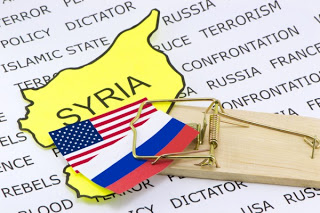Summary:
The impending collapse of ISIS has touched off a race for territory in the oil-rich eastern part of Syria pitting US-backed forces against the Russian-led coalition of Syria, Iran and Hezbollah. This is the nightmare scenario that everyone wanted to avoid. Washington and Moscow’s armies are now converging on the same area at the same time greatly increasing the probability of a conflagration between the two nuclear-armed superpowers. The only way a clash can be avoided is if one party backs down, which seems increasingly unlikely. The situation can be easily explained. The vast swath of territory captured by ISIS is steadily shrinking due to the dogged perseverance of the Syrian Arab Army (SAA) which has liberated most of the countryside west of the Euphrates River including the
Topics:
Mike Norman considers the following as important:
This could be interesting, too:
The impending collapse of ISIS has touched off a race for territory in the oil-rich eastern part of Syria pitting US-backed forces against the Russian-led coalition of Syria, Iran and Hezbollah. This is the nightmare scenario that everyone wanted to avoid. Washington and Moscow’s armies are now converging on the same area at the same time greatly increasing the probability of a conflagration between the two nuclear-armed superpowers. The only way a clash can be avoided is if one party backs down, which seems increasingly unlikely. The situation can be easily explained. The vast swath of territory captured by ISIS is steadily shrinking due to the dogged perseverance of the Syrian Arab Army (SAA) which has liberated most of the countryside west of the Euphrates River including the
Topics:
Mike Norman considers the following as important:
This could be interesting, too:
Robert Vienneau writes Austrian Capital Theory And Triple-Switching In The Corn-Tractor Model
Mike Norman writes The Accursed Tariffs — NeilW
Mike Norman writes IRS has agreed to share migrants’ tax information with ICE
Mike Norman writes Trump’s “Liberation Day”: Another PR Gag, or Global Reorientation Turning Point? — Simplicius
The impending collapse of ISIS has touched off a race for territory in the oil-rich eastern part of Syria pitting US-backed forces against the Russian-led coalition of Syria, Iran and Hezbollah. This is the nightmare scenario that everyone wanted to avoid. Washington and Moscow’s armies are now converging on the same area at the same time greatly increasing the probability of a conflagration between the two nuclear-armed superpowers. The only way a clash can be avoided is if one party backs down, which seems increasingly unlikely.
The situation can be easily explained. The vast swath of territory captured by ISIS is steadily shrinking due to the dogged perseverance of the Syrian Arab Army (SAA) which has liberated most of the countryside west of the Euphrates River including the former ISIS stronghold at Deir Ezzor, a critical garrison at the center of the fighting. ISIS is also getting pressure from the north where the US-backed SDF is pounding their capital at Raqqa while deploying troops and tanks southward to the oil fields in Deir Ezzor province.
Washington has made it clear that it wants its proxy-army to control the area east of the Euphrates establishing a soft partition between east and west. The US also wants to control Deir Ezzor’s vast oil resources in order to provide a reliable revenue stream for the emergent Kurdish statelet.
Syrian President Bashar al Assad has said many times that he will never agree to the partitioning of the country. But the decision will not be made by Assad alone. His coalition partners in Moscow, Beirut and Tehran will also help shape the final settlement. As far as Putin is concerned, it seems extremely unlikely that he’d risk a protracted and bloody war with the United States simply to recapture every square inch of Syrian territory. The Russian president will probably allow the US to keep its bases in the northeast provided that critical areas are conceded to the regime. But where will the line be drawn, that’s the question?

